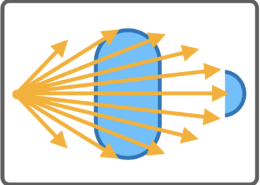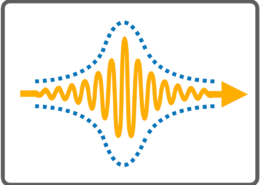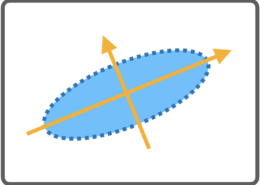
Atoms in confined media
Atoms in ultra-diluted vapors constitute the ideal physical system to carry out Quantum Physics experiments. Thanks to its low density, the interaction between atoms is negligible, and the system behaves like a set of isolated and identical quantum systems. The interaction with this atomic system can be carried out relatively easily through electromagnetic fields, usually optical. These fields allow both modifying the states of the system and measuring them, using various spectroscopic techniques. This atomic system is easily obtained in airtight containers. At room temperature, atoms move at thermal speeds, reducing interaction times to micro-seconds due to the confinement imposed by the container, and introducing very important frequency shifts due to the Doppler effect. These effects, which strongly limit the resolution of the measurements, can be substantially attenuated with specific spectroscopic techniques, or directly by reducing the velocities through optical cooling.
In the past we investigated situations of extreme confinement, such as those obtained in a fine cell with micro-metric dimensions, which imposes confinement in one dimension (1D) [Fai07][Len09][Fai10]. This situation becomes very relevant when you want to miniaturize devices such as atomic clocks, magentometers, etc.
Recently, we investigated various 2D and 3D confinement situations for atomic vapor, as described below.
Rydberg atoms
Rydberg states are electronic states of hydrogenoid (alkaline) atoms with very high energy. This implies that the excited electron is very close to the ionization threshold, or equivalently, that the electron has a very large average distance to the nucleus. This distance can be thousands of times greater than that of the electron in its lowest energy state, so the atom “fats” thousands of times when excited. This gives these states one of their most outstanding properties: their extremely high capacity to interact with external electromagnetic fields. This is due to its very high electrical and magnetic polarizability, which is multiplied by a factor of ten million. This makes these quantum states very interesting, because it allows them to interact strongly with other atoms at “macroscopic” distances that can be measured in microns. Thus, atoms in Rydberg states are ideal for generating collective quantum states, usually called super-atoms, studying coherent collective phenomena such as super-radiance, or the opposite phenomenon, sub-radiance, or constructing simulators of collective processes. such as superconductivity, or quantum processors. Another very important property of the Rydberg states is that their average natural life is very long, and in some particular cases they can “live” for seconds.
In the FCA group we began our research with Rydberg atoms a few years ago. Currently we seek to create in the laboratory, a paradigmatic system of Physics: an atom coupled to a resonant macroscopic system. In this configuration, the quantum system (atom) finds its evolution determined by the properties of the macroscopic (classical) resonant system, and of course, by the magnitude of the coupling.
Bibliography
[Lez23] “Bell non-locality in two-mode Gaussian states revealed via local squeezing”. A. Lezama and A. Auyuanet, Physical Review A, 108, 052219 (2023).
[Ben22] “Einstein-Podolsky-Rosen steering in symmetrical Gaussian states“. E. Benech, A. Auyuanet, and A. Lezama. Phys. Rev. A 106, 042201 (2022).
[You20] “Entanglement–Coherence and Discord–Coherence analytical relations for X states“. J. D Young and A. Auyuanet, Quantum Information Processing 19, 398 (2020).
[Sos20] “Miniaturized saturated absorption spectrometer“. K Sosa, J. Oreggioni and H. Failache. Review of Scientific Instruments 91, 083101 (2020).
[Fai19] “Measurement of the size of voids in dielectric media“. H. Failache, L. Amy, S. Villalba and A. Lezama, Journal of Applied Physics 126, 125103 (2019).
[Auy19] “Full statistics of ideal homodyne detection using real (noisy) local oscillator“, A. Auyuanet, E. Benech, H. Failache and A. Lezama. Journal of the Optical Society of America B, 36, 140 (2019).
[Amy17]“Two-photon excitation of rubidium atoms inside porous glass“, L. Amy, L. Lenci, S. Villalba, H. Failache, A. Lezama. Phys. Rev. A 96, 043819 (2017).
[Val17] “Probing single-photon state tomography using phase-randomized coherent states”. P. Valente and A. Lezama, J. Opt. Soc. Am. B 34, 924-929 (2017).
[Fel17] “Direct-dynamical Entanglement–Discord relations“, V. Feldman, J. Meziero, A. Auyuanet. Quantum Inf Process 16:128 (2017).
[Val14] “Experimental characterization of the Gaussian state of squeezed light obtained via single-passage through an atomic vapor“, P. Valente, A. Auyuanet, Barreiro, H. Failache, A. Lezama. Phys. Rev. A, 91, 053848 (2015).
[Vil14] “Nonlinear atomic spectroscopy inside a random porous medium“, S. Villalba, H. Failache, L. Lenci, A. Lezama. Phys. Rev. A, 90, 052518 (2014).
[Len14] “Vectorial atomic magnetometer based on a coherent transient of laser absorption in Rb vapor“, L. Lenci, A. Auyuanet, S. Barreiro, P. Valente, A. Lezama, H. Failache. Phys. Rev. A 89, 043836 (2014).
[Vil14] “Sub-Doppler resonances in the back-scattered light from random porous media infused with Rb vapor“, S. Villalba, A. Laliotis, L. Lenci, D. Bloch, A. Lezama, H. Failache. Phys. Rev. A 89, 023422 (2014).
[Vil13] “Rb optical resonance in a random porous medium“, S. Villalba , H. Failache, A. Laliotis, L. Lenci, S. Barreiro, A. Lezama. Optics Letters 38(2), 193-195 (2013).
[Len12] “A magnetometer suitable for measurement of the Earth’s field based on transient atomic response“, L. Lenci, S. Barreiro, P. Valente, H. Failache, A. Lezama, Journal of Physics B: Atomic, Molecular & Optical Physics, 45, 215401 (2012).
[Bar11] “Polarization squeezing of light by single passage through an atomic vapor“, S. Barreiro, P. Valente, H. Failache, A. Lezama, Phys. Rev. A 84, 33851 (2011).
[Vil10] “Light-induced atomic desorption and diffusion of Rb from porous alumina”, S. Villalba, H. Failache and A. Lezama, Phys. Rev. A 81, 032901 (2010) .
[Fai10] “Raman-Ramsey multizone spectroscopy in a pure rubidium vapor cell”, H. Failache, L. Lenci and A. Lezama, Phys. Rev. A 81, 023801 (2010).
[Len09] “Dark resonances in thin cells for miniaturized atomic frequency references”, L. Lenci, A. Lezama, H. Failache.Optics Letters 34(4), 425-427 (2009).
[Fai07] “Theoretical study of dark resonances in micro-metric thin cells“, H. Failache, L. Lenci, A. Lezama, D. Bloch and M. Ducloy.Phys. Rev. A76, 053826 (2007).








